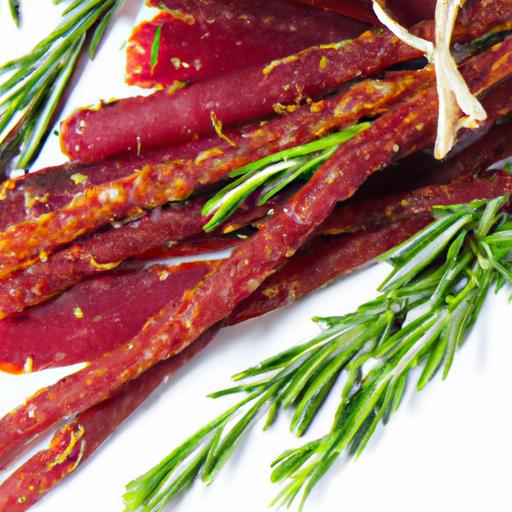In a world where snacking often leans towards the sugary and the salty, jerky stands proudly as a savory champion – a protein-packed powerhouse that fuels adventurers, athletes, and snack enthusiasts alike. But crafting the perfect jerky is an art and a science, blending the right cuts, seasoning, and drying techniques to transform humble strips of meat into chewy, flavorful bites that keep you energized on the go. Whether you’re dreaming of smoky, spicy, or subtly sweet, this guide will lead you through every step of the jerky journey, unlocking secrets to homemade perfection that’ll have you reaching for your next protein-packed treat with eager anticipation. Welcome to the ultimate roadmap for crafting perfect jerky – your delicious ticket to snack smarter and snack stronger.
Crafting perfect jerky begins with the foundational steps that transform simple cuts of meat into a protein powerhouse bursting with intense flavor and ideal texture. Selecting prime cuts and pairing them with thoughtfully crafted marinades sets the stage for your jerky masterpiece. Combined with mastering dehydration and innovative spice blends, this process ensures a snack that’s both nutritious and irresistibly delicious.
Prep and Cook Time
- Preparation: 30 minutes
- Marinating: 8-12 hours (overnight for best results)
- Dehydrating: 6-8 hours
- Total Time: Approximately 15-20 hours (including marination and drying)
Yield
- Yields about 8-10 servings (approximately 200 grams of jerky)
Difficulty Level
- Intermediate: Requires planning for marination and dehydration timing
Ingredients
- 500g lean beef (top round or sirloin), thinly sliced (about 1/8-inch thick)
- 1/4 cup low sodium soy sauce
- 2 tablespoons Worcestershire sauce
- 1 tablespoon apple cider vinegar
- 1 tablespoon brown sugar, packed
- 1 teaspoon smoked paprika
- 1 teaspoon garlic powder
- 1 teaspoon onion powder
- 1/2 teaspoon cracked black pepper
- 1/2 teaspoon liquid smoke (optional, for that campfire aroma)
- Pinch of red chili flakes (optional, for heat)
Instructions
- Choose your cut wisely: Select a lean, tender cut free from fat streaks, such as top round or sirloin. Freeze it slightly for about 1-2 hours to aid in uniform thin slicing.
- Slice with precision: Using a sharp knife, cut the meat against the grain into consistent 1/8-inch thin strips. This ensures perfect chewiness once dehydrated.
- Prepare the marinade: In a bowl, combine soy sauce, Worcestershire sauce, apple cider vinegar, and brown sugar until dissolved. Stir in smoked paprika, garlic powder, onion powder, black pepper, and liquid smoke.
- Marinate for maximum flavor: Place the sliced meat in a resealable bag or container and pour the marinade over it. Massage gently to coat. Refrigerate for 8-12 hours, allowing the meat to soak in the complex flavors.
- Drain and pat dry: Remove slices from marinade and pat lightly with paper towels to remove excess moisture, which promotes quicker, even dehydration.
- Arrange for perfection: Place strips in a single layer on dehydrator trays, ensuring pieces do not touch for air circulation.
- Dehydrate to ideal texture: Set your dehydrator to 68°C (155°F) and dry for 6-8 hours. Check periodically until jerky is dry to the touch but still pliable. Avoid over-drying to preserve chewiness.
- Cool and store: Once dried, allow jerky to cool completely. Store in an airtight container or vacuum-sealed bag to maintain freshness and flavor intensity.
Tips for Success: Elevating Your Jerky Process
- Choosing Meat: The drier and leaner the cut, the better-fat can cause spoilage. Consider bison or venison for a wild twist, adjusting marinate times correspondingly.
- Marinade Magic: Play with sweet and savory elements-try maple syrup for natural sweetness or cayenne to spice up your blend. Keep liquid smoke subtle to avoid overpowering the meat’s natural taste.
- Slicing Technique: For softer jerky, slice with the grain; for chewier bites, slice against the grain.
- Dehydrator Tips: Rotate trays halfway through dehydration for even drying; test pieces early to prevent brittleness.
- Make-Ahead: Store finished jerky in sealed jars with oxygen absorbers if planning long-term storage.
Serving Suggestions
To truly showcase your homemade protein powerhouse, serve jerky on a wooden board alongside rustic accompaniments like aged cheddar, crisp apple slices, and a handful of roasted almonds. Garnish with fresh rosemary or a sprinkle of smoked sea salt to amplify the flavor profile. Pair with a robust craft beer or bold iced tea for an elevated snack experience.
| Nutrient | Per Serving (25g) |
|---|---|
| Calories | 90 kcal |
| Protein | 12 g |
| Carbohydrates | 2 g |
| Fat | 3 g |

Innovative Spice Blends to Elevate Jerky
Experimentation is the gateway to unforgettable jerky experiences. Consider blending exotic spices like coriander, cumin, and fennel seeds toasted lightly and ground fresh for a warm, aromatic base. Infuse with a hint of dried hibiscus petals for subtle floral notes or dried chipotle powder for smoky depth. These blends awaken the palate and create jerky that’s uniquely yours.
For more inspiration on spice pairings, check out our comprehensive spice guide. To explore the science behind meat preservation, this USDA Food Safety Guide offers excellent insights into proper storage and drying techniques.
Q&A
Q&A: Crafting Perfect Jerky – Your Guide to a Protein Powerhouse
Q1: What makes jerky such a popular protein snack?
A1: Jerky is the ultimate on-the-go protein powerhouse! It’s lightweight, packed with muscle-building protein, and shelf-stable without refrigeration. That perfect balance of chewiness and savory flavor makes it a favorite for hikers, athletes, and snack lovers alike.
Q2: What types of meat can you use to make jerky?
A2: While beef reigns as the classic jerky star, the possibilities are vast! Venison, turkey, chicken, pork, and even fish like salmon can be crafted into delicious jerky. Each brings its own unique texture and flavor, so experiment to find your personal favorite.
Q3: How do you ensure your jerky is perfectly tender, not tough or brittle?
A3: The secret lies in slicing and marinating. Cut the meat thinly against the grain for tenderness. Marinate it with the right balance of salt, spices, and a touch of sweetness to lock in flavor and moisture. Dry it low and slow – patience is key to chewy, not crunchy, jerky.
Q4: What are the best marinades or seasoning blends for juicy, flavorful jerky?
A4: Classic combinations often feature soy sauce, Worcestershire, garlic, black pepper, and a hint of liquid smoke. But creativity shines here! Try spicy chipotle, sweet honey-teriyaki, or bold Cajun blends. Your marinade sets the flavor stage, so make it your own palate adventure.
Q5: Can jerky be made without specialized equipment?
A5: Absolutely! While food dehydrators simplify drying, your oven can double as a dehydrator with proper temperature control and airflow. Simply use a baking sheet with a rack and keep the oven door slightly ajar to let moisture escape. It’s DIY jerky magic in your kitchen!
Q6: How long should jerky be dried to reach that ideal texture and shelf life?
A6: Drying times vary based on thickness, meat type, and humidity, but typically 4-8 hours at 140°F (60°C) does the trick. Jerky is done when it’s firm but still pliable – bend it, and it shouldn’t snap. Proper drying eliminates moisture that fuels spoilage, giving you safe, savory bites for weeks.
Q7: What’s the best way to store homemade jerky?
A7: Once cooled, store jerky in airtight containers or vacuum-sealed bags. In a cool, dry spot, jerky can last several weeks. For longer storage, freeze it to keep that protein power fresh and ready for your next adventure.
Q8: Is jerky a healthy snack choice?
A8: When crafted thoughtfully, yes! Jerky is high in protein, low in carbs, and often low in fat, making it a smart snack for muscle maintenance and energy. Watch the sodium content, though-homemade allows you to control salt and avoid unnecessary preservatives found in some commercial brands.
Q9: How can beginners avoid common jerky-making pitfalls?
A9: Start with quality lean meat, slice uniformly, marinate overnight, and dry at the right temp. Avoid thick cuts or skipping the marinade step to prevent dry, flavorless results. Use a thermometer to ensure safe drying, and taste-test frequently toward the end to nail the perfect chew.
Q10: Why should everyone try making their own jerky?
A10: Because it’s rewarding, customizable, and delicious! Homemade jerky lets you control every ingredient, creating snack perfection tailored to your taste buds and dietary needs. Plus, it’s a stellar way to boost your protein intake with a craft you can savor, share, and show off. Ready to start your jerky journey? Your protein powerhouse awaits!
Key Takeaways
As you embark on your jerky-making journey, remember that crafting the perfect protein powerhouse is both an art and a science. From selecting prime cuts to mastering the drying process, each step transforms simple ingredients into a savory snack that fuels your adventures and satisfies your cravings. Whether you prefer classic beef, spicy turkey, or adventurous exotic meats, your homemade jerky promises unmatched flavor and nutrition. So grab your spices, fire up your dehydrator, and turn humble strips of meat into a timeless treat that powerfully packs protein into every bite. Happy jerky crafting!


